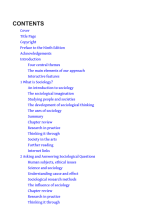Globalization and Social Change - Globalization - Elements of globalization
18 important questions on Globalization and Social Change - Globalization - Elements of globalization
Describe the 'modern world-system' of American sociologist Immanuel Wallerstein (1930-2019)
- One world economy.
- All societies are connected by capitalist economic relationships.
- Division of countries in:
- Core.
- Periphery
- Semi-periphery.
Where do the origins of the 'modern world-system' by American sociologist Immanuel Wallerstein (1930-2019) lie?
- 16th- 17th-century Europe.
- Colonialist countries exploited the countries that they colonized, which accumulated capital which was ploughed back into their own economy.
- Global division of labor created a few rich countries and impoverished other countries.
Which countries are marked as 'core countries' in the 'modern world-system' of American sociologist Immanuel Wallerstein (1930-2019)?
- Higher grades + faster learning
- Never study anything twice
- 100% sure, 100% understanding
Which countries are marked as 'Semi-periphery countries' in the 'modern world-system' of American sociologist Immanuel Wallerstein (1930-2019)?
Which countries are marked as 'Periphery countries' in the 'modern world-system' of American sociologist Immanuel Wallerstein (1930-2019)?
- Most powerless countries, with narrow economic base in agriculture or minerals.
- Source of cheap labour for core multinational corporations.
Wallerstein's theory of the 'modern world-system' is sometimes called Marx's conflict theory on a global level. Can you explain?
What are the three most pervasive criticisms of the 'modern world-system' by American Sociologist Immanuel Wallerstein (1930-2019)?
- It underplays the role of culture in explanations of social change.
- I.e., only focussed on the economic dimension.
- It underplays the role of ethnicity.
- It focusses on the nation-state as central unit of analysis, making it difficult to theorize the process of globalization.
Technologies facilitate what Harvey (1989) calls time-space compression.
What is time-space compression?
The shift of people to a global outlook has two significant dimensions. Which two?
- People increasingly perceive that their responsibility does not stop at national borders.
- It seems to be threatening or undermining many people's sense of national (nation-state) identity.
- Local identities are experiencing powerful revivals.
What is the neo-Marxist perspective on globalization?
- It accepts the multidimensional character of globalization but rejects the notion that cultural, political, and economic factors should be given equal weight.
- Key is analysing 'material interests' and the way these are pursued.
What do Urry and Larsen (2011) mean with the 'tourist gaze.'
What is a 'weightless economy?'
Which two names are often used to characterize context of a weightless economy?
- Knowledge society.
- The information age.
What is an 'electronic economy?'
What are transnational corporations?
Which two political developments have been linked to globalization?
- The collapse of communism starting in 1989 and culminating in 1991 with the dissolution of the USSR.
- The growth of international and regional mechanisms of government, bringing nation-states together (UN).
What are International governmental organizations?
- Bodies established by participating governments, that regulates or oversees a particular activity that is transcends national borders.
- E.g. United Nations.
What are INGOs and how do they differ from IGOs?
- International non-governmental organizations.
- Independent and work alongside governmental bodies.
- E.g., Greenpeace, Doctors without borders.
The question on the page originate from the summary of the following study material:
- A unique study and practice tool
- Never study anything twice again
- Get the grades you hope for
- 100% sure, 100% understanding































